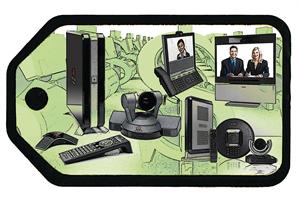

What Is Affordable Telepresence?
Telepresence conjures up images of a dedicated room with many large screens, cameras, and video codecs — and a price tag to match. But these days companies are touting affordable telepresence.
Videoconferencing is dead. Long live videoconferencing! The hybrid AV/IT application that couldn’t get out of its own way a decade ago has parted ways with its past and redefined its own future. Long live videoconferencing? These days it’s all just telepresence to me and you.
When the concept of telepresence hit the market several years ago, it was a blessing and a curse to the companies that made the systems. On the one hand, the fact that current technology could create a face-to-face experience so far superior to the mostly ineffective videoconferencing systems of the past that people might forget the industry’s prior missteps, was a blessing. On the other hand, telepresence quickly became associated with very high-end systems that came with multiple large screens and six-digit price tags. So much for building a mass-market experience and erasing memories of videoconferencing systems past.
These days, the leading manufacturers are selling what they call “affordable” telepresence systems. And they’d be thrilled if we all stopped using the V word.
“The term telepresence is a tricky one,” says Mike Baird, a senior director at the newly merged Cisco/Tandberg. “It was originally used for the high end of the market. Now we use it to describe the next generation and it encompasses quality, simplicity, and reliability.”
“The term ‘videoconferencing’ had some bad connotations,” says Laura Shay, director of product marketing at Polycom. “People thought of fuzzy images and things being hard to connect and use. So we started calling all our high-definition systems ‘telepresence.’” (Polycom continues to sell “videoconferencing” in its VSX line of standard-definition systems, but they cost the same as the company’s HDX line of HD solutions, so sales have swung toward the telepresence products, Shay says.)
In a nutshell, if you’re to describe telepresence to a technology manager or client, you’d start with high definition. Not just because the users on either end of a telepresence call look clearer on the screen, but also because of the level of information-sharing HD systems can enable. When videoconferencing got its start, many systems included document cameras for showing information to participants on the far end of a video call. But poor transmission quality undercut the combined solution. Experts say such sharing has rebounded.
“We’ve got a user who’s a chip manufacturer, like a chip you eat,” explains Shay. “They can put a chip under a document camera and because of the high definition video, from all over the world, they can tell by the way the spices are distributed on the chip if the plants are running right.”
Telepresence has also come to emphasize ease-of-use. Major manufacturers have started to offer touchscreen interfaces for their telepresence systems to make it easier for people to make video calls. After all, if no one uses the technology, it undercuts one of the industry’s basic value propositions: that telepresence pays for itself by eliminating costly travel.
Another hallmark of a telepresence solution is support for multipoint, continuous-presence conferencing, in which a hardware bridge or other device can keep four or more sites active on-screen at the same time.
Checking the Price Tags
So what does an affordable telepresence system cost? In comparison to $300,000 immersive telepresence rooms, today’s HD systems are indeed within most budgets. Polycom, for example, has begun selling its HDX 6000 View Media Center, which also serves a conference room setting and includes a codec, 42-inch LCD, a 60W sound system with subwoofer, an HD camera with built-in microphones, and a remote control, for $10,000.
In another form of telepresence, Tandberg’s EX90, which sits on a user’s desk and includes a 24-inch integrated HD display and camera (flip the camera down and it’s a document camera), as well as one of Tandberg’s new inTouch 8-inch touchscreens, sells for under $10,000. And Baird says the company sells eight E20 devices, which are 448p, 10.6-inch LCDs built into a VoIP phone, and a Video Communication Server for managing connections and bandwidth, for $30,000.
But the best thing about the new telepresence is choice. If the market agrees that telepresence is no longer just a high-end immersive room, the technology options for creating such an experience expand dramatically.
LifeSize Communications recently launched a new room system, the LifeSize Room 220, that comes with an embedded eight-way continuous presence bridge and supports up to 1080p at 30 frames per second (fps) for about $17,000 (though you can find it for less). And for quick deployment to distributed employees, the company just came out with the LifeSize Passport, an 8- by 4.7- by 1.3-inch unit that the company says can deliver 720p at 30 fps and, when you’re not really after a telepresence experience, has built-in support for Skype calls.
More choices also means more beneficial twists on the underlying technology. For example, a company called Vidyo, which sells what it calls personal telepresence, has built solutions around H.264 Scalable Video Coding. H.264 SVC is a spin on the widely adopted H.264 encoding standard designed to improve video quality on networks with bandwidth or latency issues. It’s based on the idea of slicing video frames into multiple layers, with each layer holding part of a single frame’s image and audio. Layers then travel between end points and are combined during decoding. Losing layers due to packet loss, for instance, shouldn’t affect video quality.
Despite being awash in affordable telepresence solutions, $300,000 immersive rooms will have their place. “When you look at the cost of business-class travel and the hassles that go with it, and the time you waste on the road, it can still be easy to justify immersive telepresence,” says Baird.
And frankly, not everyone will go for the whole videoconferencing-telepresence distinction. “Customers still tell us, ‘Don’t call it telepresence, it’s videoconferencing,” says Shay. To each his own.









